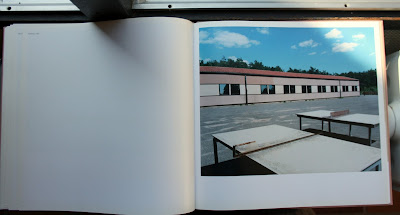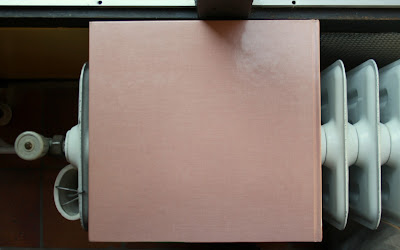Home, 1991-2002
Home is a dive inside the Swedish housing developments. On this occasion, Lars Tunbjörk goes back to his native town of Boras, where he strips his house bare. The images are both ordinary and unreal. The men and women are omnipresent in this artificial universe made to their measure. However, no human outline is visible. The white light is intense and the colors very bright. So much so that they transform these photographs into kitsch and loud posters. Exteriors alternate with interiors, but it makes no difference: the private space is as anesthetized and standardized as the public space. Both are centered by the geometry of the architecture and the furniture, which sometimes contrast with the shapelesness of a strip of land covered with thick plants or the chaos of a heap of dry undergrowth.
Lars Tunbjork: HOME. Gottingen: Steidl/Hasselblad Center, 2003. First edition. Square quarto. Pink cloth stamped in black, with plate tipped in debossed front cover, no dust jacket as issued. 106 pp. 49 color illustrations. Bibliography and exhibition history.
11.5 x 11 hardcover book with 106 pages and 49 color plates expertly separated and printed at the Steidl headquarters in Gottingen. Introductory text by Goran Odbratt. Elegant design by Greger Ulf Nilson. Published on the occasion of the 2002 exhibition Lars Tunbjork Home/Office at the Hasselblad Center, Sweden. Final volume of a trilogy with two previous titles Country Beside Itself (1993) and Office (2002).
HOME may be a portrait of a uniformed modern residential nightmare, but in its silence, the repressed personality of place humorously yet quietly resonates from the book's spreads. In these manufactured and manicured suburban landscapes, a sense of loss lingers in the atmosphere and although there is no threat, the nightmare of the suburban abyss is unavoidably evident.
"An emptiness permeates our cities, smaller towns, and moves along the roads. It did not use to be there. When it began to emerge, it went undetected for some time, suppressed beneath a kind of dizzy tipsiness that spread across the country and was everywhere, and which perhaps transformed the very fundamentals of that country. That is why I dread those houses, that sit on the outskirts of any medium sized town, and were constructed in a period of weeks early in the decade." — Goran Greider, on Lars Tunbjork's photographs
"Lars Tunbjork returns to the city, the area, the house, and the rooms where he grew up. This homecoming is not unarmed. Nobody could see this reality with the naked eye only. Through the camera, he turns our attention to matters overlooked. To the bypassed. Thus, he watches over a place that he's still belonging to. And the place responds." — Goran Odbratt, from his introduction
Published on 20 April 2015
Lars Tunbjörk – obituary
Written by BJP Editorial
Office, Food industry, Tokyo, 1999
Lawyer's office, New York, 1997
Home, Stockholm, 2000
From the series Vinter, Stockholm, 2006
From the series Vinter, Kiruna, Sweden, 2004
From the series Vinter, Kiruna, Sweden, 2004
All images © Lars Tunbjork /Agence VU
Lars Tunbjörk, the renowned photographer best known for his vividly colourful, quietly witty photography of everyday life in Sweden, has died.
Lars Tunbjörk, the renowned photographer best known for his vividly colourful, quietly witty photography of everyday life in Sweden, died this month aged 59, writes Thomas Cox.
Tunbjörk was one of Sweden’s most celebrated photographers. Headlines from Swedish media publications included epithets like “Lars Tunbjörk changed the way we see ourselves” (Sweden Radio) and “Lars Tunbjörk showed Sweden through his own melancholy” (Dagens Nyheter).
Born February 1956 in Borås, in the south of Sweden, Tunbjörk was 15 when he started taking photographs during work experience at his local newspaper Borås Tidning. After school, he began freelancing for the national newspaper Stockholms-Tidningen, before the fine art photography world first recognised his work with the Swedish Picture of the Year award for a black and white documentary picture of Swedish everyday life.
Tunbjörk’s international breakthrough came in 1993 with the book Country Beside Itself. His best-known series include Office (2001), which captures office workers in unexpected positions while working – such as under the desk – and Home (2003), in which minimalist shots of everyday things – playgrounds, flowers, armchairs – expose a quiet absurdity in Swedish suburbia.
Tunbjörk’s most recent work was a series for The New York Times last year capturing the people and environment of trailer parks on the fringes of American society.
Speaking to The New York Times in 2011, Tunbjörk said: “Especially in my older work, I was looking for strange, absurd situations, going on endless tours to festivals, campgrounds, and shopping centres. If I found an interesting place, I could stand there for hours, waiting. I often get asked if my pictures are staged. They are not.”
Throughout his career, Tunbjörk had solo exhibitions at the International Centre of Photography in New York (1995), the Moscow Photobiennale (2004) and the Gallery White Room in Tokyo (2008). His work was shown as part of group exhibitions in Photo Espania in Madrid (1998), X Biennale of Photography in Italy (2003), as well as the Photographer’s Gallery (2003) and the National Gallery (2007) in London.
Museums including MoMA in New York, the Centre Pompidou, the Maison Européenne de la Photographie in Paris and the Moderna Museet in Stockholm held samples of his work. He also won first prize in the Arts and Entertainment stories at the World Press Photo Award in 2004 for his collection of behind-the-scenes images of Paris Fashion Week.
No cause of death has been given. He is survived by his wife and two daughters.











































Geen opmerkingen:
Een reactie posten